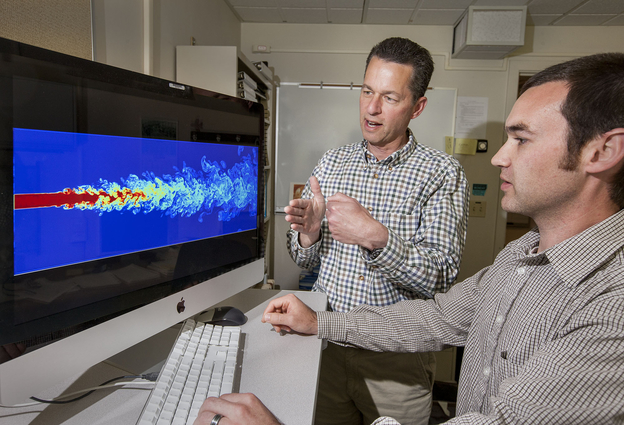New computational center brings focus and order to the study of turbulence
 (Download Image)
Greg Burton and David Dawson of the Turbulence Analysis and Simulation Center discuss a simulation of high Schmidt-number mixing by a turbulent jet. Photo by Jacqueline McBride/LLNL
(Download Image)
Greg Burton and David Dawson of the Turbulence Analysis and Simulation Center discuss a simulation of high Schmidt-number mixing by a turbulent jet. Photo by Jacqueline McBride/LLNL
The first-of-its-kind center at LLNL, the TASC will focus on high-performance simulation and analysis of turbulent mixing and reacting flows using advanced numerical methods, developed at the Lab and in academia with DOE funding, to study these problems via massively parallel computation.
"Turbulent combustion, mixing and transport problems arise in a variety of research contexts, including the study of jet, rocket and internal combustion engine design, laser fusion, climate change, weather forecasting, pollutant dispersion, wind power, aeroacoustics, and a variety of national security applications" said Greg Burton, who along with David Dawson, is taking a leading role in developing and running the center. But apart from a few isolated groups working on particular problems at the Lab, there has been no effort, until now, to concentrate this expertise or make these advanced numerical methods available for routine use widely at the Lab. "We saw a broad need and created a center that combines a staff with deep analytical understanding of these flows with the most advanced, state-of-the-art numerical methods available anywhere," said Burton.
The result, he said, will be "a leap in the sophistication and fidelity of the analysis we can do at the Lab relating to turbulent reactive and mixing flows." They are among the "most difficult problems to study on a computer," he said. "They are inherently three-dimensional systems, which means that computationally cheaper one or two dimensional studies, which are routinely used at the Lab and in industry, cannot capture many of their essential characteristics." Instead, proper study of these problems requires fully three-dimensional simulations, which are generally only possible on massively parallel supercomputers. "Very few institutions have both the know-how and the computational capability that we have concentrated here at the TASC to study these problems in all their real-world complexity," said Burton.
The TASC staff, including member Katie Lundquist and postdoc Charles Reid, "have a collective 30 years experience in the study and simulation of turbulent mixing and reacting flows," Burton said.
The TASC is also highlighting Burton's own Nonlinear LES (nLES) method, which he first developed with Professor Werner Dahm at the University of Michigan, and then significantly extended as a Postdoc and Senior Fellow at Stanford University, and here at LLNL. The nLES Method already has a number of firsts to its credit. It is the first turbulence modeling approach that can capture the local, instantaneous structure of energy transfer at the small scales in a turbulent flow, the first to calculate weakly diffusive turbulent mixing, like soot transport in the atmosphere, and the first to study ultra-high Atwood number Rayleigh-Taylor flows, of central interest to inertial confinement fusion research. These "have been 'holy-grails' of turbulence modeling for the past 50 years," said Burton, "and with the TASC, we make these revolutionary capabilities available for routine engineering analysis at the Lab."
The TASC is already working on several Lab projects, including the study of aeroacoustic noise generation by turbulence, and the turbulent mixing of contaminants in a programmatic application. TASC staff members are also collaborating with General Electric Global Research (GE) as part of the hpc4energy Incubator program, managed by the High Performance Computing Innovation Center (HPCIC), to evaluate the latest numerical methods for high fidelity simulation of turbulent spray atomization in massively parallel configurations - simulations that aim to improve the efficiency of jet engine design.
Most recently, and arising from the hpc4energy project, the TASC has been instrumental in obtaining DOE approval to conduct the largest-ever direct numerical simulation of turbulent spray atomization, to be conducted in collaboration with researchers from Cornell University on the Lab's new VULCAN supercomputer in the coming year. Burton predicted that the results of this landmark simulation will define the state-of-the-art for at least the next half-decade, and will permit unprecedented study of the spray atomization process that will lead to the development of more efficient, safer and more reliable jet engine designs.
The TASC also will be hosting a seminar series called "TASC Talks," presenting from time to time speakers on a variety of topics related to their work. Burton and Dawson invite all to visit the TASC website to learn of upcoming presentations, as well as to read write-ups and view animations and graphics from ongoing and past research projects.
Contact
Donald B Johnston[email protected]
925-423-4902
Tags
HPC, Simulation, and Data ScienceComputing
HPC Innovation Center
Featured Articles







